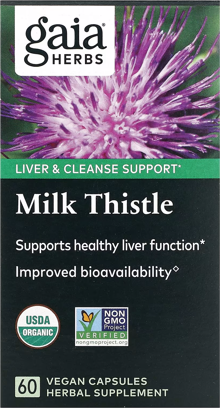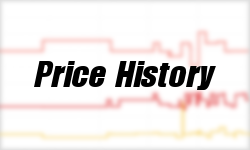
Gaia Herbs Milk Thistle Seed
Go to Store| Serving Size: 30 Drops (1 mL) | ||
| Servings Per Container: 30 | ||
| Amount Per Serving | % DV * | |
| Milk Thistle Seed Extract (Silybum marianum) | ||
| Minimum Dry Herb Strength Ratio 1:2 | ||
|
* % Daily Value (DV) is based on a 2,000 calorie diet. Your daily values may be higher or lower based on your calorie needs.
† Daily Value (DV) not established. |
||
|
Other Ingredients: Pure vegetable glycerin, water and grain alcohol USP <8%. |
||
|
Directions: Take 30-40 drops of extract in a small amount of water 3-4 times daily between meals. Shake well before using. |
||
| Serving Size: None | ||
| Servings Per Container: None | ||
| Amount Per Serving | % DV * | |
| Calories | 10 | |
| Total Carbohydrate | 2g | <1**% |
| Milk Thistle (Silybum marianum) seed extract | 600mg | †% |
| Silymarins | 270mg | †% |
|
* % Daily Value (DV) is based on a 2,000 calorie diet. Your daily values may be higher or lower based on your calorie needs.
† Daily Value (DV) not established. |
||
|
Other Ingredients: Vegetable glycerin, sunflower lecithin, vegan capsule (hypromellose, chlorophyll) and water. |
||
|
Directions: Adults take 3 capsules daily in the evening. |
||
|
Warnings: Not for use during pregnancy or lactation. If you have a medical condition or take medications, please consult with your doctor before use. Store away from children. Use only as directed on label. Safety-sealed for your protection. Keep bottle capped at all times and store in a cool dry place. Natural separation may occur. This does not affect product quality. |
||
| Serving Size: None | ||
| Servings Per Container: None | ||
| Amount Per Serving | % DV * | |
| Calories | 10 | |
| Total Carbohydrate | 2g | <1**% |
| Milk Thistle (Silybum marianum) seed extract | 600mg | †% |
| Silymarins | 270mg | †% |
|
* % Daily Value (DV) is based on a 2,000 calorie diet. Your daily values may be higher or lower based on your calorie needs.
† Daily Value (DV) not established. |
||
|
Other Ingredients: Vegetable glycerin, sunflower lecithin, vegan capsule (hypromellose, chlorophyll) and water. |
||
|
Directions: Adults take 3 capsules daily in the evening. |
||
|
Warnings: Not for use during pregnancy or lactation. If you have a medical condition or take medications, please consult with your doctor before use. Store away from children. Use only as directed on label. Safety-sealed for your protection. Keep bottle capped at all times and store in a cool dry place. Natural separation may occur. This does not affect product quality. |
||

Gaia Herbs Milk Thistle Seed
Go to StoreMilk Thistle is a herbaceous annual or biennial plant with a dense-prickly flower head and reddish-purple tubular flowers. It is native to the Mediterranean region and has been naturalized in Central Europe, North and South America, and Southern Australia. Milk Thistle has an extensive history of use as an edible plant. In the 1st century AD, Pliny the Elder reported its use for supporting liver health. Theophrastus (IV century BC) and Dioscorides (1st century AD) also wrote of its value. The English herbalist, Nicholas Culpeper (1650) claimed it was effective for supporting the normal functioning of the liver. At the turn of the 20th century, Eclectic physicians also used Milk Thistle to support healthy liver function. Much of the modern day research has been conducted in Germany where it is an approved herb in The German Commission E Monographs.*
Numerous scientific studies have explored Milk Thistle and a group of its constituents called silymarins. Many of these clinical studies have suggested that this herb supports healthy liver function and provides powerful antioxidant support. A primary constituent of silymarin called silibinin also helps to support healthy liver function.*
In addition to its well-recognized role in promoting liver health, key constituents in Milk Thistle also help to promote optimal immune function. Limited research suggests that this herb may also support healthy prostate function. More research is warranted to support the use of this herb for supporting its role beyond enhancing healthy liver function.*
References
Blumenthal M, et al. The Complete German Commission E Monographs: Therapeutic Guide to Herbal Medicines. Austin. American Botanical Council; 1998: 169-170.
Bosisio E, et al. Effect of the flavanolignans of silymarin marianum L. on lipid peroxidation in rat liver microsomes and freshly isolated hepatocytes. Pharmacol Res. 1992: 25(2): 147-154.
Chrungoo VJ, et al. Silymarin mediated differential modulation of toxicity induced by carbon tetrachloride , paracetamol, and D-galactosamine in freshly isolated rat hepatocytes. Indian J Exp Biol. 1997; 35(6): 611-617.
Dehmlow C, et al. Inhibition of kupffer cell functions as an explanation for the hepatoprotective properties of silibinin. Hepatology. 1996; 23(4): 749-54.
Dehmlow C, et al. Scavenging of reactive oxygen species and inhibition of arachidonic acid metabolism by silibinin in human cells. Life Sci. 1996; 58(18): 1591-1600.
Fantozzi R, et al. FMLP-activated neutrophils evoke histamine release from mast cells. Agents Actions. 1986; 18(1-2): 155-158.
Favari L, et al. Comparative effects of colchicine and silymarin on CCl4-chronic liver damage in rats. Arch Med Res. 1997; 28(1): 11-17.
Ferenci P, et al. Randomized controlled trial of silymarin treatment in patients with cirrhosis of the liver. J of Hepatology. 1989; 9: 105-113.
Hikino H, et al. Natural products for liver disease. In: Wagner H, et al. Economic and Medicinal Plant Research, vol. 2. New York. Academic Press;1988: 39-72.
Kropacova K, et al. Protective and therapeutic effect of silymarin on the development of latent liver damage. Radiats Biol Radioecol. 1998; 38(3): 411-415.
Luper S. A review of plants used in the treatment of liver disease: Part 1. Altern Med Rev. 1998; 3(6): 410-421.
Magliulo E, et al. [Results of a double blind study on the effect of silymarin in the treatment of acute viral hepatitis, carried out at two medical centers]. Med Klin.1978;73(28-29): 1060-1065. [article in German]
Morazzoni P and Bombardelli E. Silybum marianum (carduus marianus). Fitoterapia. 1995; 66: 3-42.
Muzes G, et al. [Effect of silimarin (legalon) therapy on the antioxidant defense mechanism and lipid peroxidation in alcoholic liver disease]. Orv Hetil. 1990; 131(16):863-866. [article in Hungarian]
Nick, G. Clinical Purification: A Complete Treatment and Reference Manual. Brookfield; LTP Publishing; 2001: 117-125.
Parish RC and Doering PL. Treatment of amanita mushroom poisoning: a review. Vet Hum Toxicol. 1986; 28(4): 318-322.
Pietrangelo A, et al. Antioxidant activity of silybin in vivo during long-term iron overload in rats. Gastroenterology. 1995; 109(6): 1941-1949.
Salmi HA and Sarna S. Effect of silymarin on chemical, functional, and morphological alterations of the liver: A double-blind controlled study. Scan J Gastroenterol. 1982:17(4): 517-521.
Schulz V, et al. Rational Phytotherapy. New York; Springer-Verlag; 1998: 214-220.
Shear NH, et al. Acetaminophen- induced toxicity to human epidermoid cell line A431 and heptoblastoma cell line Hep G2, in vitro, is diminished by silymarin. Skin Pharmacol. 1995; 8(6): 279-291.
Sonnenbichler J, Scalera F, Sonnenbichler I, Weyhenmeyer R. Stimulatory effects of silibinin and silicristin from the milk thistle Silybum marianum on kidney cells. J Pharmacol Exp Ther 1999;290:1375-83.
Zhu W, Zhang JS, Young CY. Silymarin inhibits function of the androgen receptor by reducing nuclear localization of the receptor in the human prostate cancer cell line LNCaP. Carcinogenesis 2001;22:1399-403.
General References
Wren RC. Potter's New Cyclopaedia of Botanical drugs and preparations. Essex, UK. Saffron Walden;1988.
Bartram T. Encyclopedia of Herbal Medicine. Dorset. Grace Publishers; 1995.
Leung A, Foster S. Encyclopedia of Common Natural Ingredients. NY: Wiley;1996.
Bradley P (Ed.). British herbal Compendium. Dorset. British Herbal Medical Assoc.; 1992.
Mills S, Bone K. Principles and practice of Phytotherapy. New York. Churchill Livingstone; 2000.
Ellingwood F. American Materia Medica, Therapeutics and Pharmacognosy. Portland. Eclectic Medical Publications;1985.
Tang W, Eisenbrand G. Chinese Drugs of Plant Origin. New York. Springer-Verlag;1992.
Huang KC. The Pharmacology of Chinese Herbs. Ann Arbor. CRC Press;1993.
McGuffin M, et al. Ed. AHPA's Botanical Safety Handbook. Boca Raton: CRC Press, 1997.
Newall CA, et al. Herbal Medicines: A Guide for Health-Care Professionals. London: Pharmaceutical Press; 1996.
Weiss R. Herbal medicine. Beaconsfield, UK. Beaconsfield Publishers;1985.
Felter H, Lloyd JU. King's American Dispensatory. Portland. Eclectic medical Publications; 1983.
Duke J. Handbook of Medicinal Herbs. Boca Raton. CRC Press;1985.
Hoffman D. The Holistic Herbal. Moray. The Findhorn Press;1984.
Felter HW. The Eclectic materia Medica, Pharmacology and Therapeutics. Portland, Oregon. Eclectic Medical publications;1985.
Boon H, Smith M. The Botanical Pharmacy. Quebec, Canada. Quarry press;1999.
Mills S. The Essential Book of Herbal medicine. London. Penguin;1991.
Brinker, Francis ND. Herb Contraindications and Drug Interactions. Sandy, OR: Eclectic Medical Publications;1997.
Miller L. Herbal Medicinals: Selected Clinical Consideration Focusing on Known or Potential Drug-Herb Interactions. Arch Intern Med.1998;158: 2200-11.
Newall C, Phillipson JD. "Interactions of Herbs with Other Medicines." Online. Internet. [4/26/00].
Bensky D, Gamble A. Chinese Herbal Medicine: Materia Medica. Seattle: Eastland, 1986.
DeSmet PAGM. Adverse Effects of Herbal Drugs. Berlin: Springer-Verlag. 1993
Bergner P. "Herb-drug Interactions." Medical Herbalism. 1997. Online. Internet. [5/20/99].
WHO monographs on selected medicinal plants. Volume 1. Geneva: World Health Organization. 1999.




